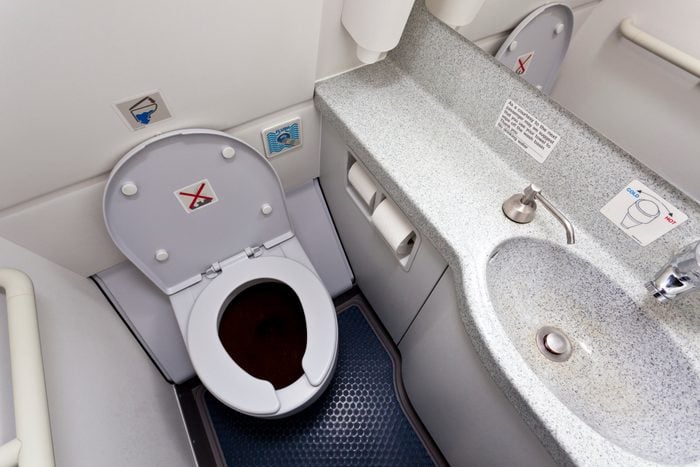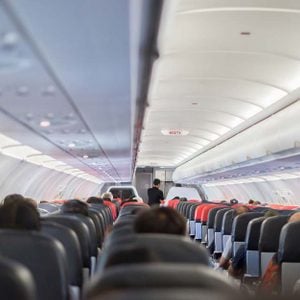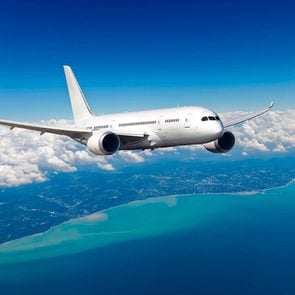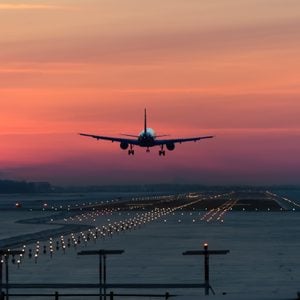What Actually Happens When You Flush an Airplane Toilet?
Updated: Apr. 28, 2022

During a given flight, travelers flush the toilets up to 1,000 times—here's what happens to all that sewage.
If you’ve ever flown on a plane, you may have thought about what happens to waste after someone uses the restroom. After all, there isn’t any plumbing up at 30,000 feet. When it comes to airplane facts, there’s a lot to learn, including why it’s so cold on airplanes, how inflight WiFi works, and why you should always put your phone on airplane mode in the sky. But now it’s time to solve the mystery of airplane toilets. Keep reading to find out what actually happens once you flush. And if you want to be even more prepared for your next flight, learn what you’re doing on a plane that flight attendants wouldn’t.
How did early airplane toilets function?
If you’ve ever imagined the contents of your airplane toilet dropping out of the bottom of the plane like a surprise crop-dusting, you’re not the only one. It’s not so far-fetched—this actually used to happen. The very earliest airplane toilets were primitive and direct: think bucket or bottle.
Airlines introduced a toilet that used Anotec—blue deodorizing gel that flushed away waste and combated odor. It wasn’t without its problems though; airlines had to store gallons of the stuff, which was very heavy and resulted in planes wasting precious fuel and having to limit passenger space. In addition, the storage tanks were directly below the toilets, so the smell would sometimes drift up into the cabin—not something you’d want to experience before tucking into your in-flight meal!
And those early toilets weren’t foolproof. Toilet waste sometimes leaked to the outside of the aircraft, where it froze. As the plane descended, it would drop icy lumps of blue gel mixed with feces, which sometimes plummeted to earth at great speed, reportedly damaging cars and houses below.
Do planes dump waste into the air?
Not anymore! Back in the days of the bucket or bottle, passengers simply hurled the contents out the airplane window onto the unsuspecting world below. Given how glamorous early flying looks in vintage photos, it may seem kind of déclassé that the toilet systems would be so subpar. But once commercial flying became popular and pressurized cabins were introduced, bathroom systems saw an upgrade as well.
Where do airplanes dump their waste?
In 1975, James Kemper designed the modern airplane toilet, which featured a nonstick bowl, a small amount of Skychem (disinfecting liquid), and powerful vacuum suction. Now when you flush an airplane toilet, a trapdoor in the base opens, liquid is released, and everything is sucked out faster than a Formula 1 race car. Waste whizzes through the plumbing to the rear of the plane, where it’s stored in sealed tanks, well away from passengers, until the plane touches down. On a long-haul 747 flight, travelers might flush the toilets around 1,000 times, creating roughly 230 gallons of sewage—that’s a lot of waste! When the aircraft lands, a “honey truck” siphons out the waste and disposes of it into the airport’s underground sewage system.
In case you’re wondering whether planes might accidentally empty the tanks in flight, delivering a nasty shock to anyone below, not to worry. The door has external clips to prevent such unexpected accidents from occurring. And if you’ve heard the urban myth about toilet vacuums sucking out your insides, that’s not likely either—at least there are no recorded incidents to date. In short, using the facilities is definitely not one of the things you should never do on an airplane. Next, find out what airplane noises you should listen for on your next flight, and why airplane seats are facing the wrong way.
Sources
- Australian Broadcasting Commission: “So a frozen ball of poop fell from the sky—should we really be worried?”
- Google: “Recirculating toilet system for use in aircraft or the like”
- Dictionary.com: “Honey wagon”
- YouTube: “How Do Plane Toilets Work? | Earth Lab”


